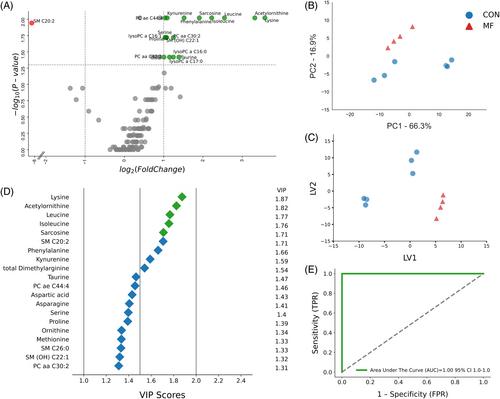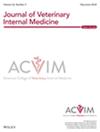Metabolomic fingerprinting of milk fever cows: Pre- and postpartum metabolite alterations
Abstract
Background
Milk fever (MF), a metabolic disorder in dairy cows characterized by low blood calcium concentrations postpartum, is well-recognized clinically. However, comprehensive data on the alteration of metabolites associated with this condition remains sparse.
Hypothesis
Delineate serum metabolite profiles and metabolic pathways preceding, coinciding with, and after the onset of MF.
Animals
Twenty-six cows, including 20 healthy cows and 6 cows initially affected by MF. Because of culling, the number of MF-affected cows decreased to 4 at MF week, +4 weeks, and +8 weeks postpartum.
Methods
A nested case-control longitudinal study was conducted, with blood samples collected at −8 and −4 weeks prepartum, MF week, and +4 and +8 weeks postpartum. Serum analysis utilized direct injection/liquid chromatography/tandem mass spectrometry (DI/LC/MS/MS) techniques.
Results
Key findings included the identification of diverse metabolites such as hexose, amino acids, phosphatidylcholines, lysophosphatidylcholines, and sphingomyelin, which varied between studied groups (P < .05). The most marked metabolic alterations were observed 4 weeks prepartum. In total, 42, 56, 38, 29, and 24 metabolites distinguished the MF group at the respective time points (P < .05). Additionally, 33 metabolic pathways, including amino acid, antioxidant metabolism, fatty acid degradation, and carbohydrate processing, were impacted (P < .05).
Conclusions and Clinical Importance
Metabolic disruptions in dairy cows begin several weeks before the clinical manifestation of MF and persist up to 8 weeks postpartum. These findings emphasize the complexity of MF, extending beyond only hypocalcemia and indicate the necessity for preemptive monitoring in dairy herd management.


 求助内容:
求助内容: 应助结果提醒方式:
应助结果提醒方式:


